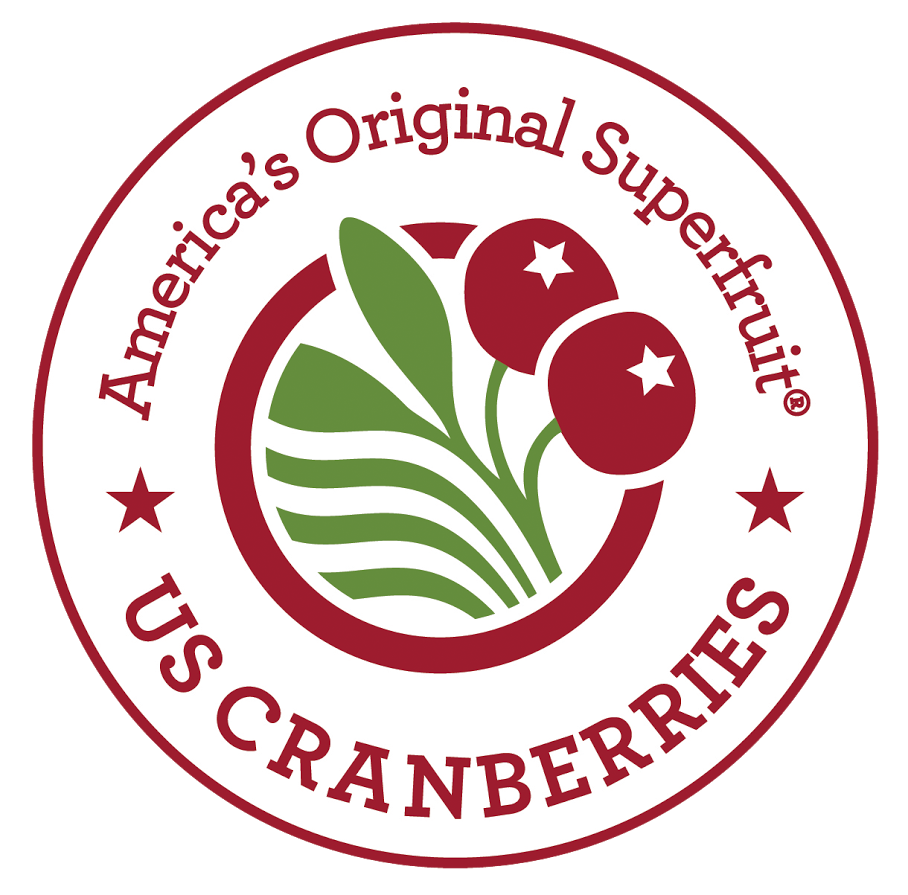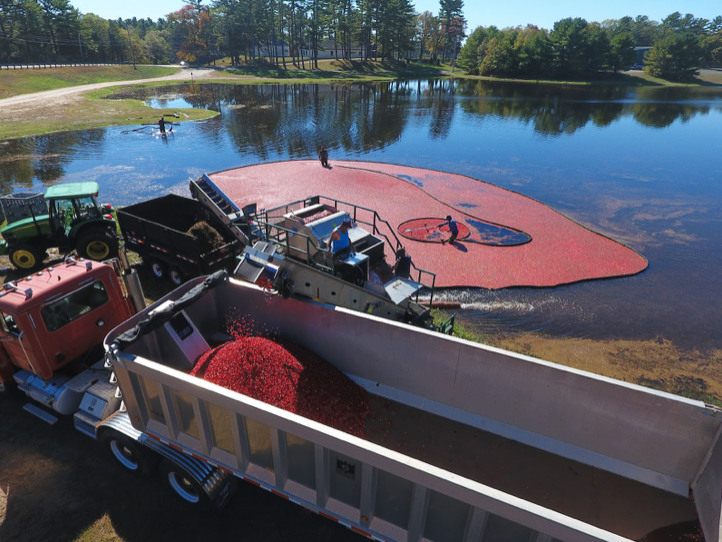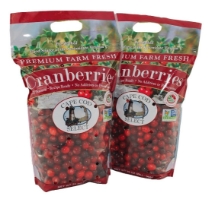The Cranberry
We get a lot of questions about how cranberries grow. Many believe cranberries grow in water but in fact they grow on low lying vines in a sandy bog. Water does play a large role in the cranberry lifecycle and harvesting though so keep reading to get the whole scoop.
 Cranberries are one of three fruits native to North America. Do you know the other two? The Concord Grape and Blueberries! As “America’s Original Superfruit” (we like to mention that)… cranberries have been around for a very long time. Native Americans used cranberries for medicine, dyes, and food.
Cranberries are one of three fruits native to North America. Do you know the other two? The Concord Grape and Blueberries! As “America’s Original Superfruit” (we like to mention that)… cranberries have been around for a very long time. Native Americans used cranberries for medicine, dyes, and food.
Let’s flash back to 1816 when Captain Henry Hall, a Revolutionary War veteran of Dennis, Massachusetts first cultivated cranberries. He noticed the sand from the Cape Cod beaches actually helped his cranberries grow better. Sanding was adopted by other growers and became industry standard. This practice is still used throughout modern cranberry growing.
Okay, now that you have a little background on cranberry history let’s flash forward to Edgewood Bogs and how we do things around here today...
There are many aspects that play into cranberry farming. Weather, water, maintenance, nutrients, harvesting, and getting cranberries into consumers hands. Luckily Cape Cod Select handles the sales since the Edgewood team has their hands full in the bogs. So let’s take you through what a normal year looks like…
In the winter t he vines are dormant. If the weather cooperates we flood the bogs and the water freezes to create a thick layer of ice. This not only helps protect the vines from harsh New England winter weather but helps us to sand the bogs as well. We actually take tractors onto the ice and spread an even layer of sand over the entire bog. When the ice melts this layer of sand slowly covers the vines and acts as a nutrient and a fresh top soil for new growth in the spring.. Basically a little refresher! It also acts as a natural pest deterrent too!
he vines are dormant. If the weather cooperates we flood the bogs and the water freezes to create a thick layer of ice. This not only helps protect the vines from harsh New England winter weather but helps us to sand the bogs as well. We actually take tractors onto the ice and spread an even layer of sand over the entire bog. When the ice melts this layer of sand slowly covers the vines and acts as a nutrient and a fresh top soil for new growth in the spring.. Basically a little refresher! It also acts as a natural pest deterrent too!
Come Spring… this is a critical part of the growing process. We prepare the bogs by pruning the vines and cleaning up the surrounding land. We also have to watch for frost which requires our crew to keep an eye on the weather every night and each morning. If the temperature drops below 32 degrees we have to run our irrigation system to prevent the vines from freezing. Frost can damage the vines and cause issues during the growing process. Let me tell you, NOBODY LIKES FROST WATCH! You lose a lot of sleep during a frost watch shift.
During this time the crew begins fertilizing the bogs with organic fish fertilizers as a natural way to add nutrients to the vines. The bees come back during this time too! With over 250 acres of cranberry bogs, you can imagine how many bees are needed. The local bees cannot do it alone so we bring in traveling hives to assist in the pollination process. During the Spring we also build and develop our land with newly renovated bogs to be more efficient. The new bogs cannot be harvested for at least two years so we always need to be planning for future crops. You can learn more about building a bog in this blog post - Building A Bog.
time too! With over 250 acres of cranberry bogs, you can imagine how many bees are needed. The local bees cannot do it alone so we bring in traveling hives to assist in the pollination process. During the Spring we also build and develop our land with newly renovated bogs to be more efficient. The new bogs cannot be harvested for at least two years so we always need to be planning for future crops. You can learn more about building a bog in this blog post - Building A Bog.
July, August, an d September the cranberries continue to grow and start to redden come late September. During this time the crew makes sure the bogs are getting enough water, prepares the processing plant, harvesting machinery, and more. We may not be harvesting cranberries year round but there is no “off season” for farmers. There is always something to be done!
d September the cranberries continue to grow and start to redden come late September. During this time the crew makes sure the bogs are getting enough water, prepares the processing plant, harvesting machinery, and more. We may not be harvesting cranberries year round but there is no “off season” for farmers. There is always something to be done!
But let’s jump to the last months of the year - cranberry season!
Typically the last week of September through mid November we are harvesting non stop! We use two methods to harvest, dry, and wet. The dry harvest is used to harvest cranberries that will be used for fresh cranberry sales. The process is much more tedious and requires a lot of hands and even a helicopter. The wet harvest is when we flood the bog and use a machine to shake the vines and the cranberries float to the surface.. We then corral the cranberries and suck them up and into a truck. It takes fewer workers and is a faster process. We use the wet harvested cranberries for our frozen products.


Okay, so we harvested the cranberries, now what? Well we bring them from the bog to the processing plant where we run the cranberries through a sorter. The sorter gets rid of sticks and leaves. It also sorts out the white and light berries, damaged fruit, and anything that’s already started to break down. We then wash the cranberries with an organic ozone wash, dry them off, and package them. The fresh cranberries are typically packed in 2lb bags and used in our seasonal gift box line, sold in select  grocery stores, or packed in bulk to be sent to bakeries, wineries, breweries, and we even have brides calling to use fresh cranberries for centerpieces. You never know who will be calling the office during this time. We joke that we need a cranberry hotline the week before Thanksgiving! The wet harvested cranberries are packaged in our 1lb packages for grocery
grocery stores, or packed in bulk to be sent to bakeries, wineries, breweries, and we even have brides calling to use fresh cranberries for centerpieces. You never know who will be calling the office during this time. We joke that we need a cranberry hotline the week before Thanksgiving! The wet harvested cranberries are packaged in our 1lb packages for grocery  stores as well as packaged in bulk packaging to supply customers looking for thousands of pounds of cranberries! We often ship the bulk overseas to customers around the world! Cranberries are only grown in certain areas so it is a pretty sought after fruit with a limited supply each year.
stores as well as packaged in bulk packaging to supply customers looking for thousands of pounds of cranberries! We often ship the bulk overseas to customers around the world! Cranberries are only grown in certain areas so it is a pretty sought after fruit with a limited supply each year.
Well there it is… the journey of the cranberry over the course of a year from bog to bag. Keep visiting our blog for more cranberry and family stories.

 BACK TO BLOG
BACK TO BLOG

